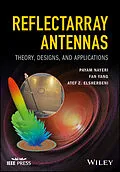This book provides engineers with a comprehensive review of the state-of-the-art in reflectarray antenna research and development. The authors describe, in detail, design procedures for a wide range of applications, including broadband, multi-band, multi-beam, contour-beam, beam-scanning, and conformal reflectarray antennas. They provide sufficient coverage of basic reflectarray theory to fully understand reflectarray antenna design and analysis such that the readers can pursue reflectarray research on their own. Throughout the book numerous illustrative design examples including numerical and experimental results are provided. Featuring in-depth theoretical analysis along with practical design examples, Reflectarray Antennas is an excellent text/reference for engineering graduate students, researchers, and engineers in the field of antennas. It belongs on the bookshelves of university libraries, research institutes, and industrial labs and research facilities.
Autorentext
PAYAM NAYERI, PhD, received his doctorate in electrical engineering from the University of Mississippi and holds a degree in applied physics. He is an Assistant Professor in the Electrical Engineering Department at Colorado School of Mines, USA.
FAN YANG, PhD, earned his doctorate in electrical engineering from the University of California at Los Angeles (UCLA), in 2002. He is a Professor in the Electronic Engineering Department, Tsinghua University, China.
ATEF Z. ELSHERBENI, PhD, is a Distinguished Chair Professor and Electrical Engineering Department Head at Colorado School of Mines, USA. He holds a doctorate in Electrical Engineering from Manitoba University, Canada.
Klappentext
A comprehensive, practical review of reflectarray theory, design, and state-of-the-art implementations
This book provides engineers with a comprehensive review of the state-of-the-art in reflectarray antenna research and development. The authors describe, in detail, design procedures for a wide range of applications, including broadband, multi-band, multi-beam, contour-beam, beam-scanning, and conformal reflectarray antennas. They provide sufficient coverage of basic reflectarray theory to fully understand reflectarray antenna design and analysis such that the readers can pursue reflectarray research on their own. Throughout the book numerous illustrative design examples including numerical and experimental results are provided.
The reflectarray antenna is a hybrid design combining many of the best features of reflector antennas and printed arrays, in a low-profile, low-mass, highly cost-effective design. Although the concept of reflectarray antennas was first introduced in the early 1960's, it did not receive serious attention until the advent of printed circuit board technology in the 1990's made it practicable. Since then continuous research on reflectarray antennas has yielded several groundbreaking applications, including multi-beam antennas for point-to-point communication, beam-scanning antennas for radar applications, and spatial power combining reflectarray systems, among others.
Featuring in-depth theoretical analysis along with practical design examples, Reflectarray Antennas is an excellent text/reference for engineering graduate students, researchers, and engineers in the field of antennas. It belongs on the bookshelves of university libraries, research institutes, and industrial labs and research facilities.
Specifically, the book:
- Provides engineers and researchers in electromagnetics, microwaves, and antennas with a systematic overview of reflectarray antenna design and analysis techniques
- Includes several design examples of reflectarray antennas along with numerical and experimental results
- Offers detailed design procedures for a wide range of applications, including broadband, multi-band operation, multi-beam scanning, contour-beams, beam-scanning systems, conformal reflectarray antennas, transmitarrays, terahertz reflectarrays, and more
- Features detailed real-world implementation examples for each design covered
Inhalt
Foreword xiii
Preface xv
Acknowledgments xvii
1 Introduction to Reflectarray Antennas 1
1.1 Reflectarray Concept 1
1.2 Reflectarray Developments 2
1.3 Overview of this Book 5
References 7
2 Analysis and Design of Reflectarray Elements 9
2.1 Phase?-Shift Distribution on the Reflectarray Aperture 9
2.2 Phase Tuning Approaches for Reflectarray Elements 13
2.2.1 Elements with Phase/Time?-Delay Lines 14
2.2.2 Elements with Variable Sizes 15
2.2.3 Elements with Variable Rotation Angles 16
2.3 Element Analysis Methods 18
2.3.1 Periodic Boundary Conditions and Floquet Port Excitation 19
2.3.2 Metallic Waveguide Simulators 19
2.3.3 Analytical Circuit Models 21
2.3.4 Comparison of Element Analysis Techniques 22
2.3.4.1 Comparison between PBC and Metallic Waveguides 23
2.3.4.2 Comparison between PBC and the Circuit Model 24
2.4 Examples of Classic Reflectarray Elements 26
2.4.1 Rectangular Patch with Phase?-Delay Lines 26
2.4.2 Variable Size Square Patch 30
2.4.3 Single Slot Ring Elements 33
2.5 Reflectarray Element Characteristics and Design Considerations 37
2.5.1 Frequency Behavior of Element Reflection Coefficients 37
2.5.2 Effects of Oblique Incidence Angles on Element Reflection Coefficients 37
2.5.3 Sources of Phase Error in Reflectarray Element Design 41
2.6 Reflectarray Element Measurements 43
References 46
3 System Design and Aperture Efficiency Analysis 49
3.1 A General Feed Model 49
3.1.1 Models of Linearly Polarized and Circularly Polarized Feeds 50
3.1.2 Balanced Feed Models 51
3.2 Aperture Efficiency 53
3.2.1 Spillover Efficiency 53
3.2.2 Illumination Efficiency 54
3.2.3 Effects of Aperture Shape on Efficiency 55
3.2.4 Effects of Feed Location on Efficiency 59
3.3 Aperture Blockage and Edge Diffraction 60
3.3.1 Aperture Blockage and Offset Systems 60
3.3.2 Edge Taper and Edge Diffraction 63
3.4 The Analogy between a Reflectarray and a Parabolic Reflector 70
3.4.1 The Offset System Configurations 71
3.4.2 Analogous Offset Reflector 72
3.4.2.1 Transformation from Reflector to Reflectarray System 72
3.4.2.2 Transformation from Reflectarray to Reflector System 75
3.4.3 Example of Analogous Offset Systems 76
References 77
4 Radiation Analysis Techniques 79
4.1 Array Theory Approach: The Robust Analysis Technique 80
4.1.1 Idealized Feed and Element Patterns 80
4.1.2 Element Excitations and Reflectarray Radiation Pattern 81
4.2 Aperture Field Approach: The Classical Analysis Technique 82
4.2.1 Complex Feed Patterns 82
4.2.2 Field Transformations from Feed to Aperture and Equivalent Surface Current 83
4.2.3 Near?-Field to Far?-Field Transforms and Reflectarray Radiation Pattern 85
4.3 Important Topics in Reflectarray Radiation Analysis 87
4.3.1 Principal Radiation Planes 87
4.3.2 Co?- and Cross?-Polarized Patterns 89
4.3.3 Antenna Directivity 90
4.3.4 Antenna Efficiency and Gain 91
4.3.5 Spectral Transforms and Computational Speedup 94
4.4 Full?-Wave Simulation Approaches 96
4.4.1 Constructed Aperture Currents Under Local?-Periodicity Approximation 96
4.4.2 Complete Reflectarray Models 96
4.5 Numerical Examples 98
4.5.1 Comparison of the Array Theory and Aperture Field Analysis Techniques 98
4.5.1.1 Example 1: Reflectarray Antenna with a Broadside Beam 99
4.5.1.2 Example 2: Re…
